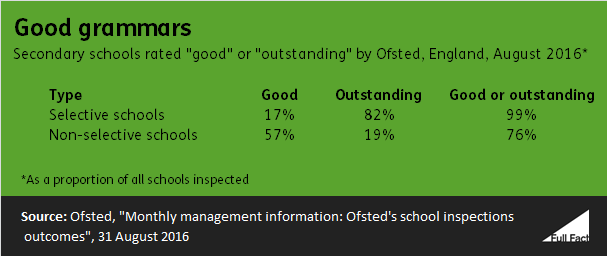This is correct. Just under 21% of inspected state schools in England were rated as outstanding for “overall effectiveness” by Ofsted inspectors.
In comparison, almost 82% of the 163 selective schools in England were rated as outstanding and 17% were rated good. That totals 99%, as the Prime Minister says
Altogether, 88% of inspected schools were rated as good or outstanding as of August this year.
This includes nurseries, primary schools, secondary schools, special schools and pupil referral units. It ignores schools that haven’t been inspected.
How do selective schools compare to other secondary schools?
All of the selective schools in England are secondary schools. Of the 3,000 non-selective secondary schools that have been inspected, 19% were rated “outstanding”. Altogether 76% were rated as good or outstanding.
While only two selective schools were rated as “requiring improvement”, or 1%, for non-selective schools 19% were in this category.
There were no selective schools rated as “inadequate”, but 8% of non-selective secondaries were.
Is there an economic effect?
Students who attend selective schools are, by definition, higher achievers, and less likely to be entitled to free school meals.
Ofsted data shows that 40% of grammar schools take their pupils from the least deprived postcodes. For non-selective secondary schools, this figure was only 20%.
You could argue that it’s easier for schools to get a good Ofsted rating in those circumstances.
Studies have looked into the relationship between the economic background of pupils and the rating received by the school. The Sutton Trust, a social mobility think tank, found that primary schools rated “outstanding” were much more likely to have pupils from a higher economic background. The report also stresses that although this was the case, one did not necessarily cause the other.
The head of Ofsted has also suggested that in selective areas good and experienced teachers are more likely to want to teach at grammars, citing research by Education Datalab.
How are schools rated?
An inspection usually lasts two days. Ofsted says that its inspectors consider:
- “overall effectiveness
- effectiveness of leadership and management
- quality of teaching, learning and assessment
- personal development, behaviour and welfare
- outcomes for pupils”
The data doesn’t mean that 88% of inspected schools were rated as outstanding or good this year. The figures are based on the ratings a school was given the last time it was inspected. For some schools that will mean this year, for others it might mean ten years ago.
It all depends on the rating a school has and whether or not Ofsted thinks they need to be inspected.
Schools that are judged to be outstanding don’t generally have to be inspected, though there are some exceptions. Instead Ofsted will monitor the school’s performance beginning three years after an “outstanding” rating to see whether or not inspections need to be done.
Schools judged to be good at their last inspection receive shorter inspections, lasting only one day. These begin three years after a “good” rating is awarded. They’ll receive a full inspection if any concerns are raised or standards are seen to decline.
What is Ofsted?
Ofsted, or the Office for Standards in Education, Children’s Services and Skills, is an independent body which reports directly to Parliament. It’s responsible for monitoring the state of services in England that care for and educate children and young people.
Ofsted inspectors visit maintained schools, academies, and some independent schools as well as other educational institutions. They also monitor childcare, adoption and fostering facilities as well as teacher training.
We’ve recently looked at the government’s proposals for selective schools as well as comparing other types of schools.
